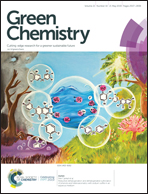High-yield synthesis of glucooligosaccharides (GlOS) as potential prebiotics from glucose via non-enzymatic glycosylation†
Abstract
This study demonstrated a high-yield process to synthesize glucooligosaccharides (GlOS) from glucose via non-enzymatic glycosylation in an acidic lithium bromide trihydrate (ALBTH, a concentrated aqueous solution of LiBr containing a small amount of acid) system. The single-pass yield of the GlOS was up to 75%, which was the highest yield ever reported. The synthesized GlOS consisted of 2–9 glucose units linked predominantly via α/β–1,6 glycosidic bonds (69%), followed by α/β–1,3, α/β–1,2, α/β–1,1, and α–1,4 glycosidic bonds. Preliminary in vitro fermentation tests indicated that GlOS could be utilized by select gut probiotic strains, suggesting that GlOS had the potential as prebiotics. The enhanced glucose glycosylation in ALBTH was attributed to the unique properties of the solvent system, including water-deficient nature, extra-high capacity of dissolving glucose, and enhanced acid catalysis. The LiBr salt could be recovered after separating the GlOS by anti-solvent precipitation and directly reused. This process provided a new approach for valorizing the biomass derived glucose into high-value oligosaccharides.



 Please wait while we load your content...
Please wait while we load your content...